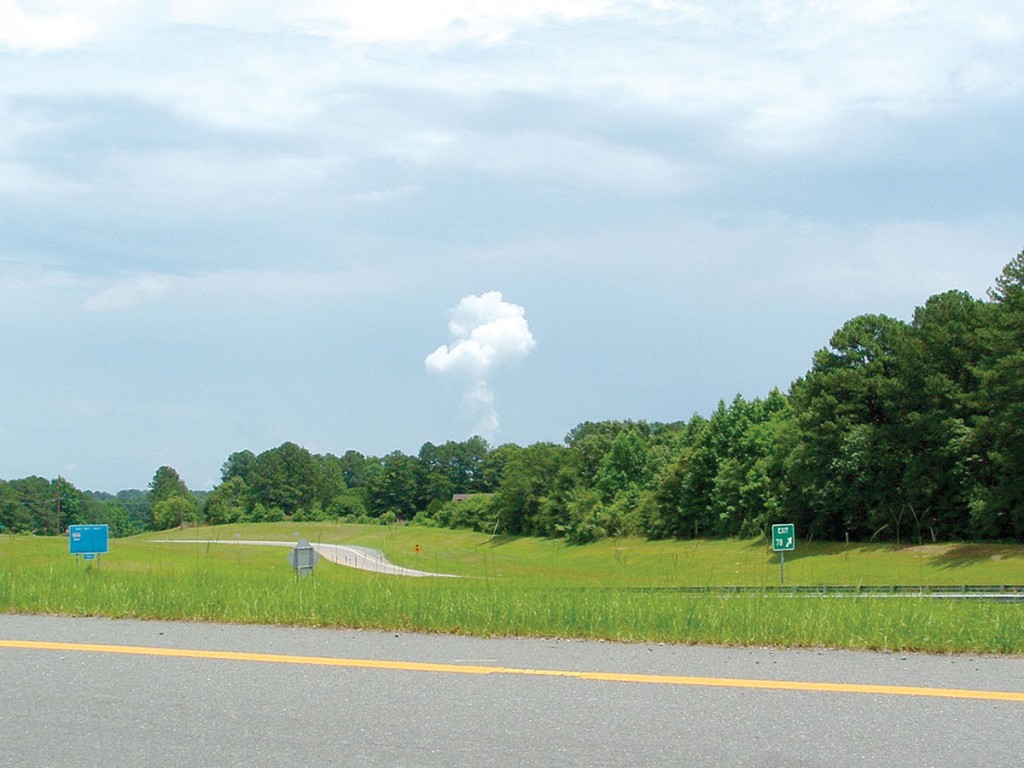
Take Exit 78 to Hiroshima?
Not quite. A little to the east, near Apex, N.C., where there is a nuclear power plant. And just ignore that cloud. It’s perfectly safe. Trust us.
Want to take a trip down memory lane? Want to just drive with no particular place to go? Drive U.S. 1 north into the Tar Heel state. You’ll pass through many a small town, hailed as a place where values and virtues die with the greatest of reluctance. Mayberry comes to mind. It was a sleepy little town where good people and memorable characters lived.
I avoid interstates when I can, so I pass through a lot of small towns and I can tell you small town America is dying, thanks in large part to interstate highways. See ‘em while you can. Last summer I drove from Raleigh to Columbia down a road once mighty, U.S. 1 South — the main road from New York City to Miami, once upon a time. It strung prosperous towns together like beads on a silver chain. Then I-95 came and tarnished the chain and the beads lost their luster. Today No. 1 runs past many an abandoned mom and pop store. All along its route, dust covers places that once thrived.
In the glory days to have a business on the shoulder of U.S. 1 was to prosper. No more. It’s easy to spot forsaken diners and gas stations from the 1950s and 1960s. Dust can cover them but it cannot destroy their classic architecture’s lines. I urge you to drive this highway to see just how much our country has changed.
Not far from Apex, N.C., you’ll see an odd white cloud ascending into the sky, a tornado of steam. It comes from a nuclear power plant. That’s how much things have changed.
As for the old diners, stores and “filling stations,” what happened to the people who built and ran these places? Where did they go?
Driving along I tried to summon up what it must have been like to see your livelihood destroyed by a monstrous freeway and the lure of saving time. Below Sanford I drove by a service station/grocery store covered in vines and suddenly it became easy. I imagined a thriving business with green-and-white hand-painted signs out front. “Fresh Vegetables.” “Red, Ripe Tomatoes.” “Cheap Gas.” And then I-95 snaked its way across the land and fewer eyes saw those simple advertisements.
The hum of tires faded and the clanging of cash registers quieted. More than one owner I’m sure made it a habit to stand in front of his store, hand shielding the sun from his eyes, scanning the road.
“No traffic. Well, not like it used to be.”
In leveling forests and plowing up fields and God knows what else to build 42,793 miles of limited-access pavement, the interstates changed America in ways few could have imagined. In 2004 Forbes magazine published “The Great Paving,” which said, “The Interstate system was sold as a savior for both rural America and declining urban cores; instead it speeded the trend toward suburbanization at the expense of both city and country. It was heralded as an antidote to traffic jams; instead it brought ever more congestion.”
You can still see vestiges of pre-interstate days. Work your way over to Camden and make a sentimental journey north on U.S. 1.
If You Go …
• Take a camera
Learn more about Tom Poland, a Southern writer, and his work at www.tompoland.net. Email day-trip ideas to him at [email protected].











